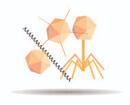
After our first post about prions, it's a comfort to learn that the rest of the germs on our countdown are able to be destroyed by cleaners! Nevertheless, each of the following germs requires careful removal to ensure a cleaner environment for vulnerable patients and individuals.
![]()
Spores
Spores can be one of two things: First, they can be a lifecycle stage for organisms that reproduce asexually (algea, fungi, etc.). This means they are a stage all the organisms go through during their life cycle, such as a seed. Second, such as in the case of bacteria, they can be a reproductive product designed to weather unfavorable environmental conditions (such as exposure to air). This means that not all bacteria that have the ability to generate spores will, only those exposed to the right (adverse) conditions. In general, all spores are able to survive in dry and freezing conditions, and some spores produce toxic chemicals. The most famous bacterial spore in healthcare is Clostridium difficile, or C. diff, while the commonly-found Apergillus is a fungal spore.
Mycobacteria
These tough bacteria have a uniquem waxy cell wall that makes them resistant to both traditional antibiotics as well as traditional cleansers. Some strains are developing resistance to broader antibiotics as well. A famous member of this notorious family is M. tuberculosis.

Non-Enveloped Viruses
These viruses are the most difficult viruses to kill, as their outer shell is made up of a material that withstands harsher environments. They enter the cell in a more destructive manner (blasting through the castle wall vs. sneaking in through a window), and do much more damage once inside the cell as they take over. These viruses are more virulent; a great example is Norovirus, also called the "stomach flu."
Fungi
Including yeasts, mushrooms, and molds, fungi are multi-cellular organisms that share similarities with plants and animals. Their cell walls are made of the same materials that form the exoskeletons of arthropods (spiders, crabs, etc), while their cells have features found only in plants. They require external food sources, like animals, but have vacuoules like plants. This hardy type of organisms can survive a very long time in adverse conditions, but is susceptible to disinfectants. A common pathogenic fungus is Candida, a yeast which causes thrush.
Bacteria
Bacteria are single-celled organisms whose insides are not "organized" into a nucleus. They are thought to be among the first life to evolve on Earth, and are by far the most common life forms on Earth today. They range in size, rate of reproduction, motility, and environmental adaptations. Oh, and they make up 9 out of 10 of the cells you call your body (but make up only 3% of your body mass). Some are susceptible to antibiotics and disinfectants, while others have developed resistance. Common pathogenic bacteria include Escherichia coli, Streptococcus pneumoniae, and Staphylococcus aureus, among many, many more.
Enveloped Viruses | Least Resistant to Disinfectants/Sterilants
Unlike their non-enveloped cousins, these viruses are the most susceptible pathogens to disinfectants. They are covered in a protein membrane that is required to sustain the virus as well as to infect cells. It is sensitive to dryness, heat, and detergents (but as with all viruses, is not effected by antibiotics). An historically lethal enveloped virus is influenza, but other examples are hepatitis, HIV, and Ebola.
As we learn more about the categories of pathogens encountered in a healthcare setting, we begin to have a better idea of the enormous challenge faced by infection control professionals. It truly is a war with many fronts when it comes to reducing infection, with each battlefield requiring specialized weapons in order to guarantee success and to ultimately win the war.
Editor's Note: This post was originally published in March 2015 and has been updated for freshness, accuracy and comprehensiveness.

